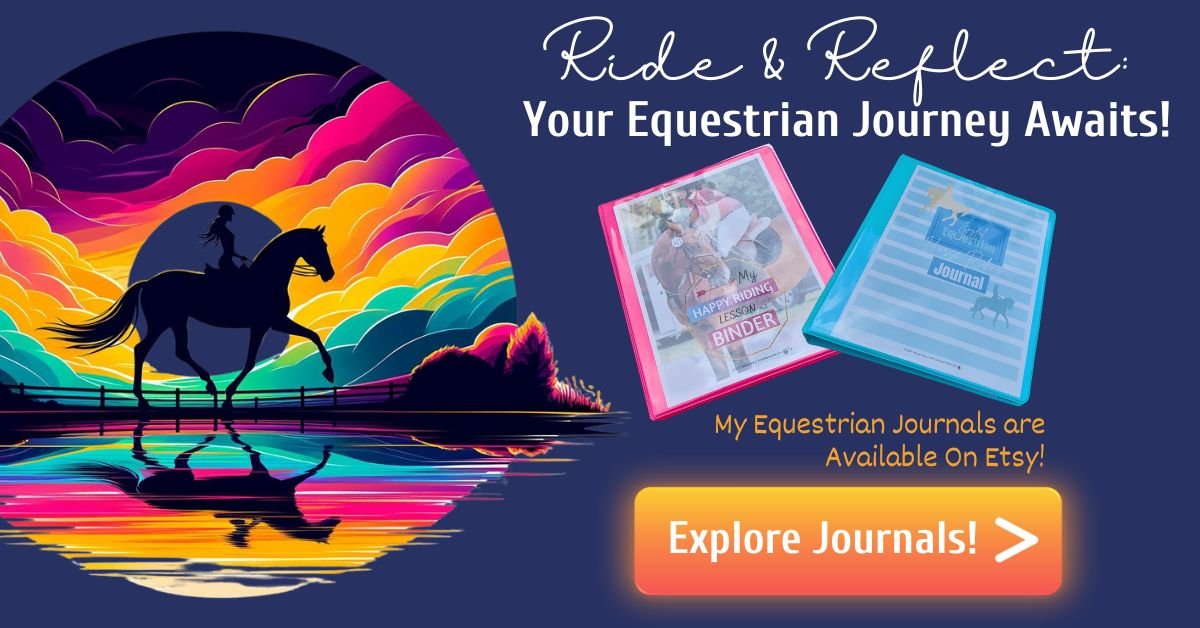Am I too old to start learning horseback riding, or can it truly be for anyone at any age?
How do beginners even find the right place to learn, and what if I’m not as quick to pick it up as others?
Will I be able to form that special bond with a horse, or is that just something people say?
It seems like there’s so much to know before even getting on a horse—gear, commands, safety. Can I really do this, or is it just a far-off dream?”
Are you looking to start horseback riding but not sure where or how to begin your journey? As a kid, I was lucky enough to have a best friend who was already taking riding lessons, so I had some sort of guidance from her on how to get started with horse riding.
But not everyone has that luxury so this post is for anyone interested in horseback riding and eager to get started, but doesn’t have connections. In this post you will get a full look at starting, choosing the right school, gear, and riding style, while also covering safety, lessons, and building relationships with horses.
It’s essential for new riders to start off informed and inspired, and to have the answers to the main questions about getting started.
How To Get Started With Horseback riding
Wondering how to get started in the world of horseback riding? Stepping into this new world is thrilling, and yes, a bit overwhelming at first, especially with all the new terminology—terms like “frog,” “gaskin,” “green,” and “gelding” can certainly be puzzling!
Here’s a roadmap to kickstart your equestrian journey:
- Find a Reputable Riding School or Instructor: Start by searching online for riding schools, stables, or equestrian centers in your area. You can also look into professional organizations affiliated with the United States Equestrian Federation (USEF) or local riding associations, as they often maintain directories of accredited instructors. Don’t forget the power of word-of-mouth—ask friends or family for recommendations.
- Inquire and Learn: Once you’ve found a potential place, reach out directly to learn about their beginner programs and lesson structures. Many offer introductory lessons to assess your comfort level with riding.
- Essential Gear for Beginners:
- Helmet: Safety first! Ensure you have a properly fitted riding helmet.
- Footwear: Boots or shoes with a small heel and good ankle support are essential.
- Clothing: Opt for comfortable, long pants and a shirt with sleeves to avoid snags.
Here’s a quick review of the very basics of getting started and your action steps:
- Find: Search for schools or instructors.
- Inquire: Ask about beginner programs and introductory lessons.
- Gear Up: Ensure you have a helmet {yours or the barn’s}, appropriate footwear, and comfortable clothing.
I will be explaining more of all this in detail First lessons will typically focus on getting to know horses, learning to mount and dismount, and mastering basic controls. Remember, every rider started as a beginner, so be patient with yourself. The most important part is to enjoy the journey and the incredible connections you’ll build with these beautiful animals.
So, take it step by step, and don’t hesitate to discuss any concerns with your instructor. Safety and proper technique are crucial, so always learn with the guidance of a qualified instructor.
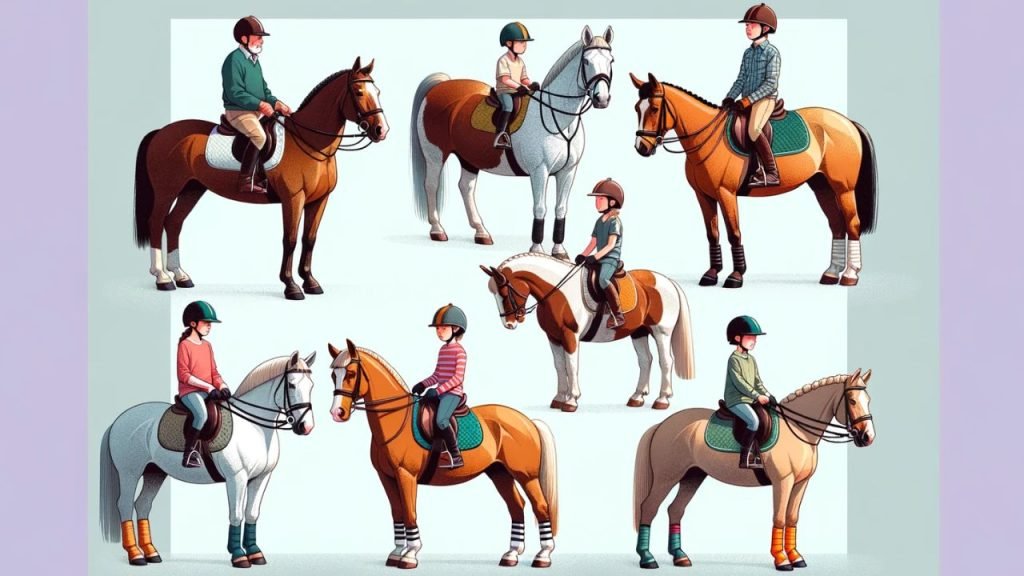
Age To Start Horseback Riding
You’re never too old to start learning horseback riding! This enriching activity offers immense joy and fulfillment, along with physical, mental, and emotional benefits like improving balance, flexibility, strength, and reducing stress.
For example, I started lessons at 8 years old, but one of my best friends didn’t start until she was in college and I also had several riding lesson students who were well over 60 just starting out. Horseback riding is accessible to almost all ages.
Age-Specific Considerations:
Young children (2-4 years old): While some programs introduce them to horses through pony rides or leading walks, the focus is on familiarization and fostering a love for horses, not formal lessons.
Ages 4-6: Children might begin basic riding lessons with a strong emphasis on following instructions, balance, and building confidence around horses.
Age 6 and above: This is a common starting point for many riding schools as children typically possess better:
- Physical strength and coordination for proper maneuvering and balance while riding.
- Cognitive abilities to understand and follow instructions effectively.
- Maturity level to handle potential situations that arise while riding.
Remember:
- Comfortable Pace: Start with a reputable instructor who caters to adult beginners, tailoring lessons to your fitness level and goals.
- Specific age restrictions may vary depending on the riding instructor or program.
- Age is just one factor; a child’s physical development, coordination, and ability to follow instructions are crucial aspects.
- It’s important to consult with riding schools or instructors directly. They can assess a child’s individual readiness and offer programs suitable for their age and development.
RELATED BLOG POST>> Too Old To Ride A Horse? Why You’re Never Too Old!
RELATED BLOG POST>> The Best Age For Kids To Start Horse Riding: Can A 2 Year Old Ride A Horse?
The equestrian community is typically welcoming and supportive, celebrating riders of all ages and backgrounds. So, if you have the desire to ride, there’s absolutely nothing stopping you from pursuing that passion at any stage in life.
Health and Fitness Requirements for Riding
Riding horses does require a basic level of health and fitness, but don’t let that deter you. Many riders, including myself, have started their journey at various fitness levels. It’s normal to notice sore muscles in unexpected places and feel out of breath after trotting.
The essence of horseback riding lies in its ability to improve your fitness naturally over time. Starting with shorter, less intense sessions is a great way to let your body adjust to this new form of exercise.
Essentials for a Safe and Enjoyable Riding Experience:
- Core Strength and Cardiovascular Health: A strong core and good heart health support stable positioning and smooth movement with the horse. This is essential for both safety and enjoyment, especially at faster gaits or during longer rides.
- Balance and Coordination: Essential for maintaining stability and harmony with your horse. These skills are crucial for effective communication and interaction through body movements.
- Leg Strength and Flexibility: Important for gripping the horse and maneuvering effectively. Flexibility aids in achieving a deeper seat and synchronizing with the horse’s movements.
Health Considerations and Preparations:
- Consult Healthcare Professionals: If you have pre-existing conditions, especially those affecting balance, coordination, or cardiovascular health.
- Be Aware of Weight Limitations: Riding schools may have restrictions to ensure the welfare of their horses.
So again, you don’t need to be in peak physical condition to begin horseback riding. Focusing on core strength, leg strength, and overall balance will not only enhance your riding experience but also foster better communication with your horse. If you’re new to the equestrian world, adopting a gradual approach to increase the intensity and duration of rides as your fitness improves is advisable.
Most importantly, ensure your riding journey is enjoyable and listen to your body, communicating any concerns with your instructor to contribute positively to your well-being.
RELATED BLOG POST>> Horseback Riding Weight Limit: How Much Can A Horse Carry?
Horseback Riding: Age-wise Benefits & Fitness Guide
Look at this table below to take a brief glimpse at some of the rewards and fitness needs for horseback riding across different ages.
| Age Group | Benefits of Horseback Riding | Health and Fitness Requirements |
|---|---|---|
| Children | – Improves balance and coordination – Enhances concentration – Encourages responsibility and empathy | – Basic motor skills – Ability to follow instructions |
| Teenagers | – Builds confidence and self-esteem – Provides a positive outlet for energy – Develops discipline and focus | – Good physical health – Flexibility |
| Adults | – Improves posture and core strength – Reduces stress and anxiety – Offers social opportunities and a sense of community | – Basic fitness level – Core strength and flexibility |
| Seniors | – Maintains mobility and flexibility – Lowers the risk of chronic diseases – Enhances mental well-being | – Doctor’s approval (if applicable) – Stable mobility |
finding a reputable riding school
Wondering how to find a reputable riding school? It requires some digging but is entirely worth the effort. Start by tapping into the wisdom of local horse owners, friends who ride, or even veterinary clinics for recommendations. Don’t underestimate the power of social media and online forums focused on horse riding in your area, alongside a good old ‘riding lessons near me’ online search.
Key Steps for Your Search:
- Ask Around: Word-of-mouth from those with riding experience is invaluable.
- Online Research: Utilize search engines, look for riding schools with detailed programs, instructor qualifications, and facilities.
- Professional Organizations: Check out affiliates of bodies like the United States Equestrian Federation (USEF) for directories of accredited instructors.
- Reviews: Online testimonials give insights into teaching styles and school atmosphere.
- Direct Contact: Call or visit potential schools to inquire about programs, safety procedures, and get a firsthand feel.
After narrowing down your options, it’s crucial to visit the schools. Observing a lesson, meeting the instructors, and checking the facilities can tell you much about the school’s operation and whether it aligns with what you’re looking for. Look at the stable’s cleanliness, the condition of the horses, and how everyone (both humans and animals) is treated.
Having ridden at numerous barns over 25 years, I can say each has its unique approach to teaching, horse care, and facilities. Doing thorough research and taking your time to find the right barn from the start can save you from needing to switch later. Remember, it’s okay to move on if a place doesn’t feel right after some time. But ideally, finding a school that feels like a good fit initially is your best bet.
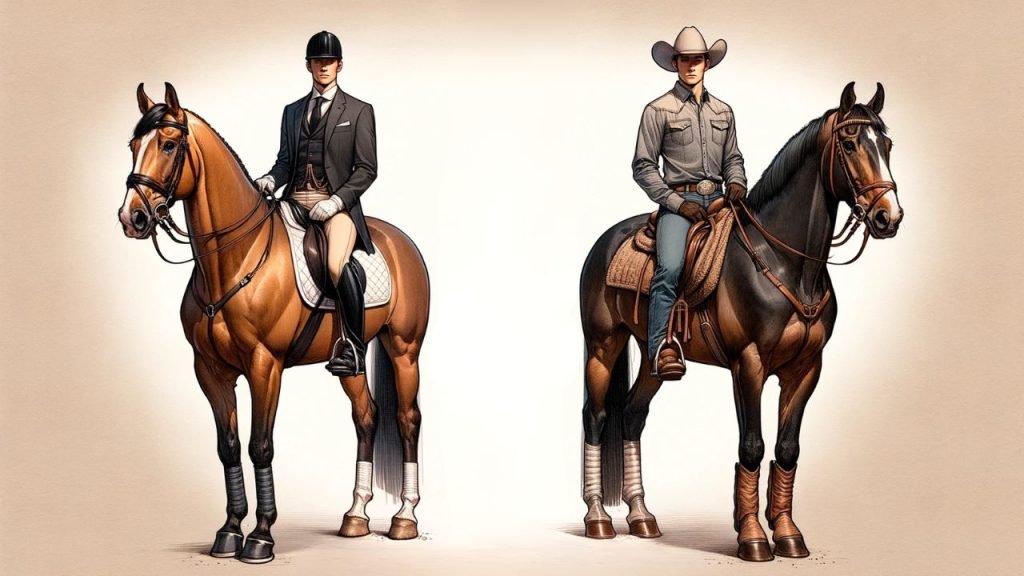
choosing A Horseback Riding Style
Now you may be thinking what styles of horseback riding are there and how do I choose one?
There are two main styles of horseback riding: Western and English.
Western riding, often associated with ranch work and rodeo events, uses a larger, more comfortable saddle designed for long hours of riding. It’s known for activities like trail riding, barrel racing, and roping. English riding, on the other hand, is more traditional in Europe and involves a closer contact saddle. It’s popular for disciplines like show jumping, dressage, and eventing.
Choosing between them depends on what you’re drawn to:
- If you love the idea of working with horses in a more casual, outdoors setting, or the culture of rodeo appeals to you, Western might be your style.
- If you’re intrigued by precision, formal competition, and a wide range of disciplines, English could be more up your alley.
Many riders try both before deciding which path to follow. No matter your choice, both styles offer rewarding experiences and a chance to bond with horses. I have done both Western and English and there are many more distinct disciplines within each of these styles.
Here is a table to more visually compare the super basic differences between Western and English side by side:
| Aspect | Western Riding | English Riding |
|---|---|---|
| Discipline Focus | Often centered around ranch work and rodeo activities. Focuses on versatility, utility, obedience and laid back demeanor. | Traditionally associated with formal competitions and disciplined styles such as jumping, dressage, and eventing. |
| Saddle Type | Features a larger, more comfortable saddle with a horn on the front, designed for long hours and providing greater stability. | Utilizes a lighter saddle that allows for more precise commands and closer contact with the horse. |
| Common Activities | Trail riding, barrel racing, roping, reining and western pleasure are popular activities. | Hunters, Show jumping, dressage, eventing, and English pleasure are common disciplines. |
| Ideal For… | Riders interested in a casual, outdoor riding experience, western style or the cultural aspects of rodeo, ranching and western horsemanship. | Individuals drawn to precision, formal competition, jumping and a wide range of riding disciplines. |
What To Wear To Your First Riding Lesson
Wearing a riding helmet is a must for your first lesson and every ride after that. Safety always comes first, and a well-fitted, certified riding helmet can protect you from serious injury.
You don’t necessarily have to buy one immediately; many riding schools provide helmets for beginners. However, if you plan to ride regularly, investing in your own helmet ensures it fits you perfectly and meets your comfort preferences.
Not to mention people get lice, not saying the helmets will have lice but schools often teach not to share hats at school soo… Also riders using the school helmets are sweating in them, so you are wearing a helmet other people are sweating in. Personally I would go for your own helmet if this is going to be a more permanent or long term hobby.
RELATED BLOG POST>> Best Beginner Riding Helmet: Why Choose The Ovation Deluxe Schooler Helmet In 2024
For your attire, choose comfortable, snug-fitting clothes that won’t get caught in the equipment. Long pants like jeans or leggings protect your legs from getting a saddle rub. A t-shirt or a long-sleeve shirt works well for your upper body, depending on the weather.
Riding boots with a smooth sole and small heel (about 1 to 1.5 inches) are ideal because they prevent your foot from getting stuck in the saddle as well as slipping all the way through the stirrup.
Gloves are optional but can help grip the reins and protect your hands from rubs.
RELATED BLOG POST>> The Budget Friendly Guide For What To Wear Horseback Riding
So in review here are the very basics of what to wear to your first lesson:
- ASTM/SEI approved riding helmet (may be provided by lesson barn ask first if you need to buy one)
- Comfortable, close-fitting clothes
- Boots with a smooth sole and a small heel
Remember, comfort and safety are key, so wear clothes and boots that fit well and give you confidence as you ride.
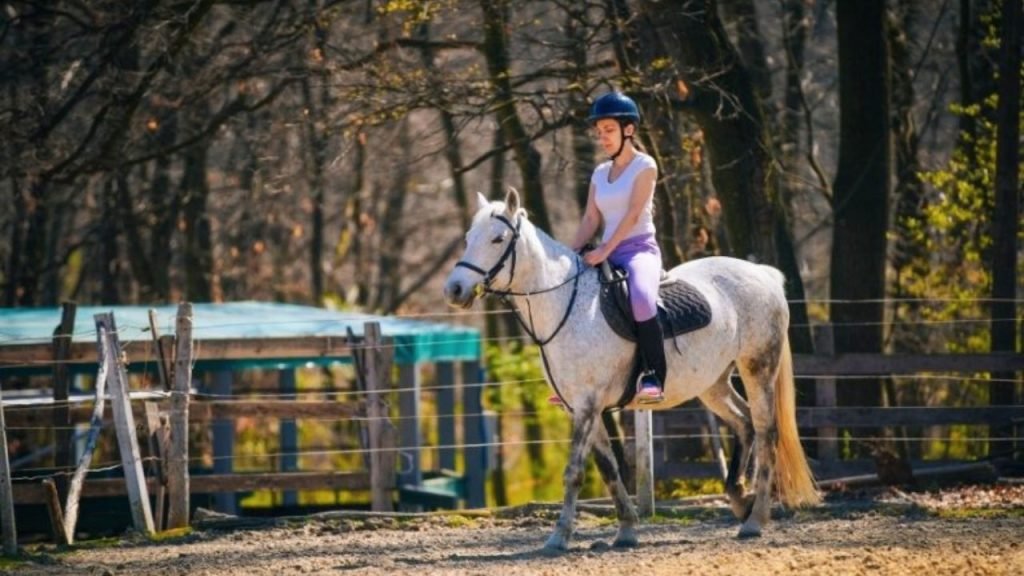
What To Expect in Your First Riding Lesson
In your first riding lesson, expect a mix of excitement and learning the basics.
RELATED BLOG POST>> What To Expect At Your First Riding Lesson: Free Printable Checklist Included
Your instructor will likely start by teaching you how to safely approach and interact with horses, emphasizing the importance of calm and confident body language. You’ll learn how to properly lead, groom, and tack up your horse, which are essential skills for any rider. I find that many new riders are surprised to learn that a good portion of the lesson is learning these things.
The next part of the lesson is riding, which will begin with mounting the horse correctly and finding your balance in the saddle. You’ll get familiar with the basic commands to control the horse, such as how to ask it to walk, stop, and turn. Don’t worry if you don’t get everything right away; it’s all about building a foundation and getting comfortable being on horseback.
The focus will be on safety and establishing a connection with the horse. Enjoy the process, and remember, every expert rider was once a beginner too!
Then after riding, usually you will take care of the horse, and put the tack away. When you get more experienced your instructor will most likely have you come a half hour early or more to get ready for the lesson, so more of the lesson time will be spent in the saddle.
How Do I Approach and Interact with Horses Safely?
Approaching and interacting with horses safely is crucial for both your and the horse’s well-being.
RELATED BLOG POST>> How To Approach A Horse (Horse Handling Basics)
Always approach a horse from the front or side, never from behind, so they can see you coming and won’t be startled. Speak calmly and softly to announce your presence, as sudden movements or loud noises can spook them. Offer your hand for the horse to sniff, similar to how you’d let a dog smell you, which is a polite way to introduce yourself in the horse’s world.
Always move around a horse with a slight touch, keeping your hand on their body so they’re aware of where you are. This is especially important when moving around their rear. It is best to avoid going behind them whenever possible.
Remember, horses are prey animals by nature, so they might kick if startled. Understanding and respecting their space, and using calm, gentle movements, will help ensure safe and positive interactions between you and the horse.
How Often Beginners Should Take Riding Lessons
As a beginner, the frequency of your riding lessons can greatly affect your progress and confidence.
RELATED BLOG POST>> How Often Should I Take Horseback Riding Lessons?
Ideally, taking lessons once or twice a week is a good start.
This schedule allows you to learn and practice regularly without overwhelming you or the horse. It gives you enough time between lessons to absorb what you’ve learned, think about any questions you might have, and look forward to your next ride with excitement.
If you’re particularly eager and have the time (and budget), twice a week can help you improve more quickly. However, remember that rest and reflection are as important as practice.
Riding is not just about physical skill; it’s also about building a relationship with your horse and understanding its behavior, which takes time to develop. Whatever frequency you choose, consistency is key. Regular lessons help maintain your momentum and build your skills steadily.
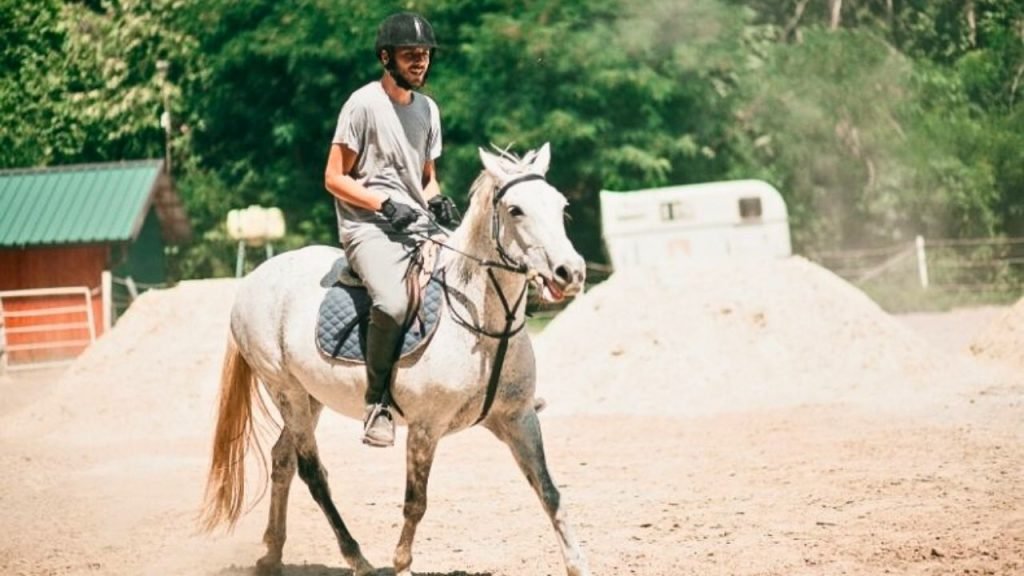
Common Mistakes Beginners Make and How To Avoid Them
Beginner riders often make many mistakes, it just comes with the territory of learning something new. But being aware of them can help you avoid the same pitfalls.
RELATED BLOG POST>> How To Ride A Horse For Beginners: Ultimate Guide
Here are a few of the common mistakes beginners make:
- Tensing up
- Incorrectly holding the reins
- Looking down at the horse or your hands
- Not asking questions
First, many beginners tense up, which can make you feel unbalanced and communicate nervousness to the horse. Try to relax your body and breathe deeply to stay calm and centered.
Second, not holding the reins correctly can lead to miscommunication with your horse. Learn to hold them firmly but gently, allowing for subtle cues rather than harsh pulls.
Third, looking down at the horse or your hands is a habit to avoid. Always look in the direction you want to go, which helps with balance and direction.
Lastly, beginners sometimes forget to trust their instructor or feel embarrassed to ask questions. Remember, every rider was once a beginner, and asking questions is a crucial part of learning. Your instructor is there to help, so make the most of their knowledge and experience.
How To Build a Good Relationship with Your Lesson Horse
Building a good relationship with your lesson horse starts with respect and patience.
RELATED BLOG POST>> How To Get A Horse To Trust You: A Step By Step Guide
Here is a quick look at actionable steps you can take to start building a relationship with your lesson horses:
- Spend time grooming and just spending time around the horse.
- Approach calmly and speak softly.
- Pay attention to their likes and dislikes.
Spend time with them before and after lessons, if possible, to establish a bond. Grooming is a great way to connect; it’s not only helpful for the horse’s coat and skin but also a comforting activity that can relax both of you.
Remember to always approach them calmly and speak softly, letting them get used to your presence and voice.
Pay attention to their likes and dislikes—some horses enjoy a scratch on the neck or a gentle pat, while others may not. Treats can be a nice reward, but ask your instructor first, as they’ll know what’s best for the horse’s diet and training.
Finally, be consistent in your actions and emotions around them. Horses are incredibly sensitive to human feelings and behavior, so staying calm and positive can help build trust.
Remember, building a relationship takes time, so be patient and enjoy the process of getting to know each other.
the Next Steps To Mastering Basic Riding Skills
Once you are at the point that you have mastered the basic riding skills, you’re ready to explore more challenging and rewarding aspects of horseback riding.
The next steps will of course depend on your interests and goals but here are some of your potential steps you may decide to take.
1. Explore specific riding disciplines.
You could delve into specific riding disciplines such as dressage, jumping, eventing, or western riding like barrel racing and trail riding. Each discipline requires learning new skills and techniques that build on the basics you’ve already mastered.
RELATED BLOG POSTS>> 58 Horse Disciplines: Discover A World Of Equestrian Sports!
2. Join a riding club or group.
Consider joining a riding club or group to meet other riders with similar interests. It’s a great way to learn from others and find opportunities to participate in events or competitions, if that’s where your interests lie.
3. Continue education through workshops, clinics, and lessons.
Continuing your education is also key. Attend workshops, clinics, and lessons with different instructors to broaden your understanding and refine your skills. This could also include learning more about horse care, behavior, and training, which will deepen your connection with horses and enhance your overall riding experience.
Remember, horseback riding is a journey of lifelong learning, so embrace the new challenges and opportunities that come your way.

How To Continue Learning and Improving Outside of Your Lessons
To continue learning and improving outside of your lessons, immerse yourself in the equestrian world as much as possible.
RELATED BLOG POST>> Improve Your Riding At Home | 13 Ways To Get Better At Riding Without A Horse
Reading books and watching videos on riding techniques and horse care can deepen your understanding and enrich your riding experience.
Practice exercises that enhance your balance, flexibility, and core strength, as these are crucial for effective riding. Joining online forums or local equestrian clubs can also connect you with fellow riders, offering advice, experiences, and perhaps opportunities to ride together.
Additionally, my blog, JoyfulEquestrian.com, is a resource designed to support your journey. It covers a wide range of topics, from practical riding tips and horse care advice to personal growth through horseback riding. I share insights from my own experiences and lessons learned along the way, aiming to inspire and guide fellow equestrians at all levels. Whether you’re looking for detailed how-tos or motivational stories, you’ll find content to help you grow both in and out of the saddle.
Wrapping Up
My hope is that you now feel inspired and confident about beginning your journey in horseback riding, regardless of your age or initial skill level. This information should have demystified the process of getting started.
If you need a review of what you learned about, here is a quick list of key takeaways:
- Anyone Can Start: Age is not a barrier to learning horseback riding; it’s suitable for all ages.
- Health and Fitness: Basic health and fitness are required, but riding also helps improve your physical condition.
- Finding the Right School: Research and recommendations are crucial for finding a reputable riding school or instructor experienced with beginners.
- Essential Gear: Necessary gear includes a helmet, comfortable clothes that won’t snag, and riding boots with a smooth sole and small heel.
- Riding Styles: There are two main styles of riding: Western and English. Choose based on your interest in casual riding or precision and competition.
- First Lesson Expectations: Expect to learn about approaching and interacting with horses, basic controls, and the importance of building communication with your horse.
- Safety First: Learn the correct way to approach and interact with horses to ensure safety.
- Lesson Frequency: Beginners should ideally take lessons once or twice a week to progress steadily.
- Common Mistakes: Avoid common mistakes such as tensing up, holding the reins incorrectly, and not asking questions.
- Building a Relationship: Spend time grooming and being around your lesson horse to build a bond.
- Next Steps: After mastering the basics, explore specific disciplines and consider joining clubs or groups to meet other riders.
- Continuous Learning: Engage with the equestrian community, read books and blog posts, watch videos, and practice exercises to improve outside of lessons.
For more equestrian insights, dive into my additional related blog posts you’ll find throughout the post as well as at the bottom of this post. Each offers valuable knowledge and tips, perfectly complementing what you’ve started to discover here, enriching your horseback riding journey.
Excited about starting your horseback riding adventure?
Head over to my Joyful Equestrian Etsy shop and check out my printable equestrian journals. Begin your horseback riding adventure with one of my Joyful Equestrian journals. Perfect for goal setting, tracking progress, and reflecting on your rides. Elevate your journey today!
